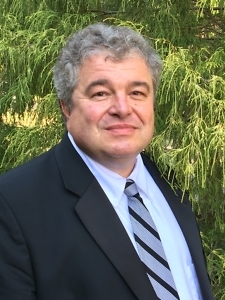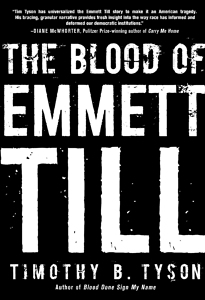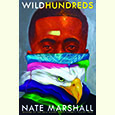Memory, Outrage, and Courage
Timothy B. Tyson updates the story of Emmett Till’s murder
The brutal killing of fourteen-year old Emmett Till by Mississippi white supremacists in 1955 was met by unparalleled public shock and outrage. Told and retold on television, and in newspapers and magazines, it was unlike any other racially motivated killing before it—but not because such murders were rare. Despite the tireless efforts of activists to make racial hatred visible to the public, despite their countless attempts to elicit even the smallest protections from the federal government, hate crimes remained mostly hidden from public view before Emmett Till was murdered.

As historian Timothy Tyson shows in The Blood of Emmett Till, this boy’s death changed all that. Emmett’s mother, Mamie, led a crusade for justice, inspiring worldwide attention by insisting that her son’s corpse, with its disfigured, almost unrecognizable face, be put on public display and shown in the media. The killing made terrifyingly real the symbols central to white supremacy in America: a hyperbolic version of “pure” white womanhood threatened by an equally hyperbolic caricature of “beastly” black manhood.
What Emmett Till was accused of—flirting with a white woman—was hardly a crime. He was also a boy. This combination of innocence and youth made his murder all the more horrific and sensational. After an all-white jury exonerated his murderers, despite clear evidence for their guilt, Mississippi became even more notorious, a synonym for the unyielding nature and violent potential of Southern segregationism.
Historians and those nearest to the case have told the story of Emmett Till a few times now. Stories like this, by their nature, merit new treatments, but there are potential pitfalls. If the retelling becomes a ritual and the name “Emmett Till” simply an incantation, then the human story gets lost amidst the cause of which it became a part—we no longer know much about who Emmett Till was. On the other hand, if the case becomes another sensationalistic episode in the “true crime” genre, this time made piquant by racial taboo, then the cause gets lost amidst the lurid details of the case—we forget about the cause of freedom, then and now.
Luckily Tyson, the morally serious memoirist of Blood Done Sign My Name, has chosen to write this history anew. His story here is neither lurid tale nor political iconography. The Blood of Emmett Till recounts both the murder and the trial that followed it, but Tyson also explores the context for these events. In his final chapter, he compares past and present, noting the use of Till as an icon in Black Lives Matter protests and showing how “Decades after his death, Emmett continues to be a national metaphor for our racial nightmares.” Tyson means to tell us something about Emmett Till, ourselves, and our national history as a whole.
Tyson also has information that previous historians lacked: Carolyn Bryant, Till’s accuser and the former wife of one of his murderers, granted him an interview, and Tyson also has the transcript of Bryant’s autobiography. But the incident itself—the events immediately before, during, and after the killing—are only part of this story. Tyson also weaves together multiple strands of context. He describes Emmett Till, his family, and the racial climate of their home city of Chicago in the years leading up to 1955, as well as the world of his murderers, J.W. Milam and Roy Bryant, in Mississippi. He contrasts the rise of black activism in Mississippi after World War II with the organization of Mississippi’s white supremacists in response to the Brown decision. He also tells the story of the “Mississippi Underground,” a group of black activists who sought justice for Emmett Till and his family at great personal risk.
 Tyson is best with intimacies, when he writes about local people and their relationship to one another and to place. He takes special care with mise en scene, providing a rich portrait of the world of Emmett Till, his murderers, the circumstances that contributed to the murder and to the trial’s outcome, and the eventual impact of those things on the civil-rights movement both North and South. This risky approach could come off as a kind of narrative crazy-quilt, but Tyson is a gifted storyteller, and the strands come together here.
Tyson is best with intimacies, when he writes about local people and their relationship to one another and to place. He takes special care with mise en scene, providing a rich portrait of the world of Emmett Till, his murderers, the circumstances that contributed to the murder and to the trial’s outcome, and the eventual impact of those things on the civil-rights movement both North and South. This risky approach could come off as a kind of narrative crazy-quilt, but Tyson is a gifted storyteller, and the strands come together here.
Style matters in a book like this. When good and evil are evident, moral indignation comes easily, and readers might feel self-congratulatory, relieved that we are nothing like that anymore. We need historians like Timothy Tyson to break that spell for us. Describing the moment when Till’s murderers seized Emmett from his uncle’s house, Tyson writes, “Twenty-five white-tufted acres of cotton, almost ready for harvest, stretched out behind his unpainted clapboard house in a pitch-black corner of the Mississippi Delta called East Money. He had lived his entire life in the Delta, and he had never had any trouble with white people before.” That final, simple statement of fact breaks up the pastoral idyll. The reader knows that the outcome will be unspeakable violence. The setting rises to the level of metaphor for the story as a whole.
Moments like this are powerful. They take us back to the human story, which can’t be disentangled from the larger moral story. Reverend Moses Wright, the man jarred awake from that Southern idyll, is also a great hero in this tale. In the courtroom, at unimaginable personal risk, he identified J.W. Milam, the ringleader of the murdering band who took Emmett Till. He pointed at him, and he said it plain: “There he is.” By telling the story of Emmett Till in a new way and also by saying it plain, Tyson aims to wake us up. He means to inspire in his readers some small measure of the moral courage summoned up by Moses Wright. Let’s hope his readers are listening.

Peter Kuryla is an associate professor of history at Belmont University in Nashville, where he teaches a variety of courses having to do with American culture and writes scholarly articles about American political thought and the civil-rights movement.


